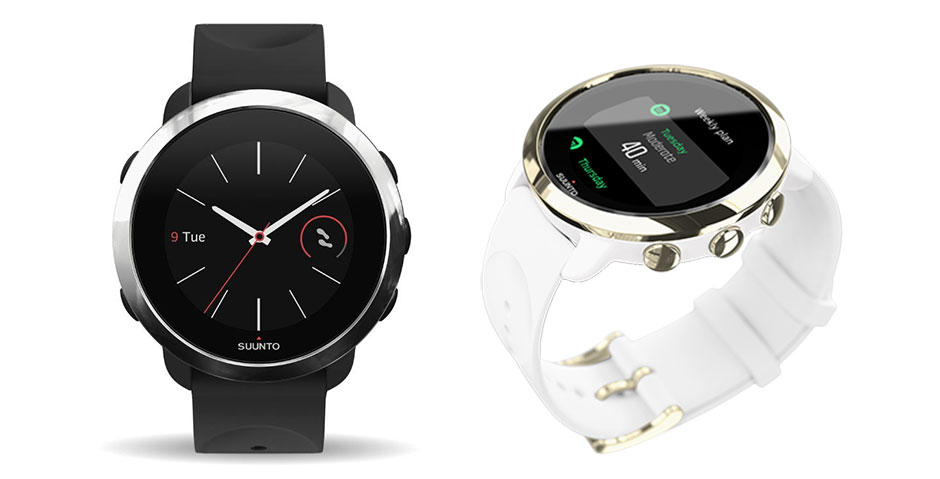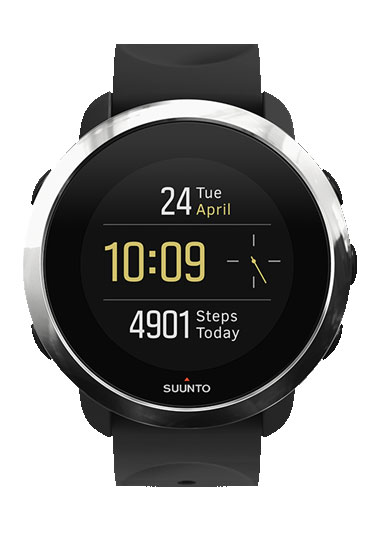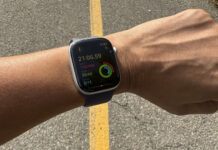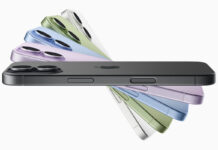
Over the past few years, smart watches and fitness trackers seem to have gone from being unique accessories of choice for technophiles and elite athletes to combination devices that even the least “techy” or fit among us can—and does—wear. From monitoring incoming text and email messages to keeping tabs on heart rate and calories expended, smartwatches have quickly become an integral piece of the puzzle when it comes to staying on top of overall health; all while staying connected, of course.
Because of this, and because I’ve gone from being relatively fit to not-so-fit, I’ve contemplated the idea of adding a smartwatch to my everyday repertoire of accessories as a reminder to step it up in the exercise department, but I have yet to bite the bullet. Needless to say, when I was asked to give the Suunto 3 Fitness smartwatch a whirl, I jumped at the chance.
Introducing the Suunto 3 Fitness smartwatch
 The new Suunto 3 Fitness smartwatch was developed by Suunto, a Finnish outdoors and adventure company that until recently made products that appealed to what I consider extreme athletes: trail runners, downhill mountain bikers, divers, and pretty much anyone who considers the risk of injury or death part of their daily exercise regime. The Suunto 3 on the other hand, was designed with a broader audience in mind.
The new Suunto 3 Fitness smartwatch was developed by Suunto, a Finnish outdoors and adventure company that until recently made products that appealed to what I consider extreme athletes: trail runners, downhill mountain bikers, divers, and pretty much anyone who considers the risk of injury or death part of their daily exercise regime. The Suunto 3 on the other hand, was designed with a broader audience in mind.
By “broader,” I don’t just mean people who still like to jump off cliffs and go shark diving for the fun of it on a Saturday, but people like me who are trying to get back into healthy habits, or even people who are well versed in their fitness regime, but want to monitor certain key metrics so they can adapt their habits as needed.
First Impressions of the Suunto 3

Prior to receiving the Suunto 3 Fitness smartwatch, I did a little online sleuthing to get a sense of what people who had already purchased or reviewed it thought. Interestingly, one of the common comments was that it had a very “slim” design. Given the fact that I am a minimalist when it comes to my accessories, this made me very happy.
However, while I found the watch face and strap to be quite on the slim side, the watch itself felt like it was about half an inch thick and stuck out quite high on my wrist. That said, the strap itself was silicone, making it very comfortable and lightweight, which was awesome for those days when I worked up a sweat.
I was also a little surprised that navigating the functions of the Suunto 3 isn’t done by touch or swiping. Instead you navigate through a variety of buttons on the sides of the watch face. There is no rationalization as to why I assumed I would be swiping my way to my ultimate fit self, nor was this a deal breaker, but I feel that it is something worth mentioning since swiping and touch have become so commonplace with tech devices in general.
Overall though, I really liked the look of the Suunto 3. I was sent the black model, but the white and gold model is definitely more my style.
Testing the Suunto 3 Fitness smartwatch
I wore the Suunto 3 Fitness smartwatch every day for six days, and during that time eased back into my fitness regime by walking home from downtown three evenings that week, and working out twice at home. Here’s what I thought of each of the Suunto’s main features:
Activity Tracking
 As is the case with many smartwatches, the Suunto 3 Fitness automatically counts your daily steps and calories. Because I’m on a mission to lose the <undisclosed> pounds I’ve managed to put on in what some might think is an impressively short period of time, calories in versus calories out was what I was most interested in tracking.
As is the case with many smartwatches, the Suunto 3 Fitness automatically counts your daily steps and calories. Because I’m on a mission to lose the <undisclosed> pounds I’ve managed to put on in what some might think is an impressively short period of time, calories in versus calories out was what I was most interested in tracking.
My smartphone tracks my steps, and on average, when I walk home, it tracks me at about 8,000 total daily steps. The Suunto, however, recorded total steps of well over 12,000 on two days. I used that (and the associated calorie expenditure) as an excuse to eat chicken wings and drink beer more often than anyone should in a single week, but it did seem a little on the high side. What I discovered is that every time I swung my arm, regardless of whether or not I was sitting, standing, walking, or sipping a pint of the aforementioned beer, the Suunto tracked the motion as a step, and in some cases, many steps. As it turns out, this is pretty standard with fitness trackers, but not something I was prepared for, so it’s important to know that the steps are not necessarily 100% accurate.
 As far as calorie count was concerned, I also thought the tracking was a little on the high side. I use an app tto track my calories and it records my “walk home” calorie expenditure as about 350 calories. The Suunto recorded a number more than double that. However, this is the first true fitness smartwatch I’ve ever really put to use, and given my excess weight at the moment, and the fact that it is using my heart rate to make its measurements, it could very well be accurate.
As far as calorie count was concerned, I also thought the tracking was a little on the high side. I use an app tto track my calories and it records my “walk home” calorie expenditure as about 350 calories. The Suunto recorded a number more than double that. However, this is the first true fitness smartwatch I’ve ever really put to use, and given my excess weight at the moment, and the fact that it is using my heart rate to make its measurements, it could very well be accurate.
While I found both the steps and the calories expended to be a little excessive, I did lose four pounds in one week, so perhaps it is all the other devices and apps I’ve used in the past that are inaccurate.
Sleep Tracking
When you wear the Suunto at night, it tracks how long you slept, the quality of your sleep, and how well your sleep supports your recovery. This was super cool to me, as it became very clear that the reason I am almost always tired is because I am not sleeping solidly, or for very long. This is definitely a feature I didn’t think would be useful, but it made me acutely aware of the tie my sleep has to my health, and I’ve been working hard to get longer and sounder sleep since.
Wrist Heart Rate
The Suunto 3 Fitness also tracks your heart rate, which is a phenomenal feature. As a result of my aforementioned I-have-become-less-fit-and-put-on-a-few-pounds situation, my blood pressure is a little on the high side. During one of my home workouts, my heart rate was on the crazy high side, so I eased off a bit to get it to come down. This is something I never would have done before. Instead, I would have said to myself “if you’re about to pass out and feel your heart beat behind your eyes, you are burning crazy calories.” Understanding where your heart rate is during a work out isn’t just nice to see, but exceptionally important from a health perspective.
Stress and Recovery
The Suunto 3 Fitness measures your stress and recovery to help you ensure you have enough in the tank to make it through the day. In my week with the device, I almost always registered as being stressed, even when I was chilling on the couch with a movie. Again, while this may sound suspect, I’m ridiculously out of shape so it is very probable that jumping back into exercise after a very long hiatus taxed my system to the point that I was stressed the majority of the day.
 Connected GPS
Connected GPS
The GPS functionality was something I struggled with, with the Suunto 3 Fitness. Every time I began a walk or a workout, the Suunto prompted me to ensure the Suunto app was connected to the Internet. It was. Always. However, it didn’t seem to register. That said, in the diary on the Suunto app, my distance travelled was tracked, so this was clearly a glitch with my watch, my phone, or the Suunto app itself.
Adaptive Training Guidance
This is one of the features that sets the Suunto out from the pack. Based on your fitness level and recorded training history, the Suunto 3 Fitness creates a seven day training plan with optimal duration and intensity for each exercise to improve your fitness. Unfortunately, with only one week with the product, I wasn’t really able to discover just how useful this feature could be. I think that with a few weeks of tracking under your belt, this feature would be beyond useful when it comes to hitting your fitness goals.
A few other things worth mentioning
- The battery life of the Suunto is nothing to sneeze at. If you’re tracking your activity 24/7, the battery can last up to 5 days. For me, it lasted a full four before I was notified that it needed to be charged. If you only use the “time mode” the battery can last up to 10 days, but to me that negates the purpose of the watch itself.
- The Suunto is water resistant up to 30 meters. I didn’t take it swimming or diving, but I did shower with it with absolutely no problems whatsoever. On a side note, I burned 100 calories washing my hair!
- Incoming calls, texts, emails, and social media notifications all come through the Suunto 3 Fitness, which I didn’t think I’d like, but found I absolutely loved! Especially when I was exercising or in a meeting.
Things I liked about the Suunto 3 Fitness
First and foremost, I loved the calorie tracking and step counter, regardless of whether or not I felt it was inaccurate due to my previous experience with other apps and my smartphone. I also really liked the fact that you can change the watch face depending on what you want to see at a glance. For example, if you want your step tracking to be displayed, you can choose that option. If you want a standard analog watch face, you can opt for that as well. You can also change the colour scheme of your watch face to match your mood or outfit, so that was a plus for me.
I also really liked how I was notified of my text messages, emails and other social media alerts through the phone. In all honesty I didn’t think this would be something I would enjoy, but these alerts are so much less intrusive when you are working out, hanging out with friends, in a meeting, or otherwise not glued to your phone than monitoring them from your smartphone might be.
Things I didn’t like
It’s difficult to say what I didn’t like considering the fact that I only tested the Suunto 3 Fitness for a week and that a number of its features are tied to trends over time. However, I didn’t necessarily love having to navigate all its features through buttons since I am used to touch screens and swiping. I also didn’t love how high my steps and calorie expenditure was, because I wasn’t confident that the measurement was accurate.
Overall, I wish I had more time with the Suunto 3 Fitness smartwatch. As mentioned, given the fact that many of its functions are tied to trends over time, my time with it wasn’t enough for those to be established. That said, I loved having an ongoing step count on my watch face, and I equally loved being able to see how many calories I had expended at any given time during the day.
Being able to monitor my heart rate while exercising was also a big plus, and as cheesy as it sounds, so was being able to customize the watch face to match my aesthetic.
In a nutshell, I feel that this is a smartwatch that any user needs to spend some time with before all its benefits are showcased. I feel that the Suunto 3 Fitness is a true smartwatch in that its aim is to customize workout schedules to match the incoming data, and then use that data to push you to another level.


